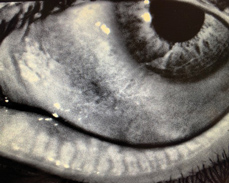MGD may be culprit in contact lens intolerance
Thermal pulsation treatment could help patients experience more comfortable lens wear.

It is often assumed that contact lens intolerance is an unavoidable consequence of aging, and that patients will drop out of contact lens wear as they become older. In many cases, however, contact lens wearers are able to sustain successful wear well into older age — if underlying ocular surface disease is appropriately addressed.
A recent patient is a great example of this. This 65-year-old female high myope had successfully worn gas permeable (GP) contact lenses for 50 years but had been struggling with increasing contact lens intolerance over the past 3 to 5 years. Symptoms included redness, tearing, foreign body sensation (FBS) and heavy protein deposits — so much so that she was removing the lenses to clean them eight to 10 times daily. Despite this, the deposits would return almost immediately after cleaning, leaving her with fluctuating vision and discomfort.
She was wearing Boston Fluoroperm 60 lenses (Paragon), -9.50 OD, -8.50 OS. As her intolerance worsened, a number of alternatives had been considered. Several soft contact lens trials were unsuccessful. Her central corneal pachymetry was too thin for LASIK, especially given the high refractive error. Her symptoms had not improved with Restasis (cyclosporine, Allergan), Xiidra (lifitegrast, Novartis), over-the-counter omega-3 supplements or punctal occlusion.
Exam findings

Source: Shilpa Rose, MD
The patient had a history of rheumatoid arthritis, for which she had been taking Plaquenil (hydroxychloroquine sulfate, Sanofi-Aventis) for 10 years. A recent electroretinogram had shown no evidence of toxicity. Her past ocular history included some perimacular drusen, for which she was taking the AREDS 2 nutritional supplement.
When I examined her, the best corrected visual acuity was 20/25 OU. She had mild ptosis in both eyes, and IOP was normal, at 14 mm Hg OU. The slit lamp exam was notable for conjunctival perilimbal staining, dense superficial punctate staining and a mild papillary reaction of the palpebral conjunctiva. There was 1+ nuclear sclerosis. A dilated fundus exam revealed perimacular drusen with no evidence of other macular degenerative changes.
The contact lens exam revealed well-positioned GP lenses that moved well, but with a heavy coating of protein deposits. There was mild telangiectasia of the lid margins and meibomian gland inspissation and capped glands. Diagnostic expression of the glands revealed turbidity in the meibum and a mild toothpaste-like consistency to the excretions. LipiScan meibography (Johnson & Johnson Vision) showed good gland structure, with no evidence of gland dropout or atrophy.
This presentation is actually common. There have been reports for decades of an association between meibomian gland dysfunction (MGD) and contact lens intolerance (Korb et al.). Contact lens wear may actually predispose individuals to MGD. A report in Cornea found that contact lens wearers were more likely to have abnormal meibum, hyperemia, lid margin telangiectasia and plugged meibomian orifices compared to age-matched controls (Machaliska et al.). In this study, 60% of the contact lens wearers had MGD, even though not all were symptomatic.
Treatment and results
The good news for my patient in this case is that while the poor meibum quality and inspissation indicated functional changes in her meibomian glands, she still had very good gland structure. In my experience, this type of patient responds well to thermal pulsation therapy (LipiFlow, Johnson & Johnson Vision), a short, in-office procedure in which the meibum is gently heated to the melting point from the inner surface of the lids and the glands are massaged to express them comfortably. LipiFlow has recently been shown in a prospective multicenter trial to increase mean comfortable contact lens wear time by approximately 4 hours (Blackie et al.). The gain in wear time in the study was accompanied by a gain in comfortable hours as a percentage of total wear time and improvements in symptoms, frequency of artificial tear use and Ocular Surface Disease Index scores.
One week after her initial visit with us, this patient underwent thermal pulsation therapy. She was also prescribed Lotemax gel (loteprednol 0.5%, Bausch + Lomb) three times daily for 1 week to address inflammation and irritation and started on a higher dose of omega-3 supplementation (2,668 mg daily) than she had taken previously.
One month later, the patient was seen for follow-up. After years of unsuccessful treatments and increasingly challenging contact lens wear, she reported that she was now wearing her GP lenses comfortably for up to 10 hours per day, without needing to remove them to clean off deposits. The redness and FBS had resolved. Examination revealed that the contact lenses were still well-positioned, but with no protein deposits. There was minimal conjunctival and corneal staining. At another follow-up appointment 6 months after the thermal pulsation treatment, the patient reported that she was still able to wear contact lenses comfortably all day, without fluctuations in vision.
We know that MGD is a chronic condition that is likely to require ongoing management. In this case, the patient did experience a return of symptoms, albeit milder in nature, about 18 months after the initial treatment. She elected to undergo a second LipiFlow treatment at that time and remains happy with the results thus far.
This patient was highly motivated to remain in contact lenses but was struggling due to MGD-related discomfort and visual fluctuations. Treatment of her MGD was instrumental in resolving her symptoms and supporting continued contact lens wear.
References:
Blackie CA, et al. Clin Ophthalmol. 2018;doi:10.2147/OPTH.S153297.
Korb DR, et al. J Am Optom Assoc. 1980;51(3):243-251.
Machalińska A, et al. Cornea. 2015;doi:10.1097/ICO.0000000000000511.
For more information:
Shilpa Rose, MD, practices at Whitten Laser Eye and Chesapeake Eye Care in Chevy Chase, Md.
Disclosures: Rose reports she is a consultant for PRN and Johnson & Johnson Vision.

